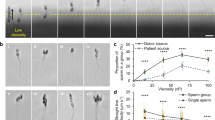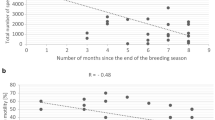Abstract
THE fluorescent dye, quinacrine, binds strongly to the Y chromosome and only to a lesser extent to the other chromosomes in human metaphase cell preparations1. A bright fluorescent spot (F body), which is presumed to be the Y chromosome, is clearly visible in stained interphase cells from various tissues from the human male2–5 and in mature spermatozoa6,7. Spermatozoa bearing one F body (about 45 % of the total) are taken to be Y spermatozoa, and the staining method is now being used widely to detect physical differences, for example, in DNA content and head size7,8 and motility9 between X and Y spermatozoa, and for testing the efficiency of procedures designed to separate them10–13. Spermatozoa bearing two F bodies (about 1.3% of the total) have been interpreted as YY spermatozoa7,8, and the relatively high number of such spermatozoa has led to speculation concerning the seemingly high non-disjunction rates during spermatogenesis8,14,15. We here examine the factors which affect Y chromosome visibility in sperm heads, and conclude that the F body count depends critically on observer performance, that the presence of YY spermatozoa cannot be demonstrated decisively using the quinacrine stain, and that measured physical differences between spermatozoa with and without an F body may partly reflect a dependence of the Y chromosome detection efficiency on the size of the sperm head.
This is a preview of subscription content, access via your institution
Access options
Subscribe to this journal
Receive 51 print issues and online access
$199.00 per year
only $3.90 per issue
Buy this article
- Purchase on SpringerLink
- Instant access to full article PDF
Prices may be subject to local taxes which are calculated during checkout
Similar content being viewed by others
References
Caspersson, T., Zech, L., and Johansson, C., Expl Cell. Res., 60, 315–319 (1970).
Robinson, J. A., Ann. Hum. Genet. Lond., 35, 61–65 (1971).
Polani, P. E., and Mutton, D. E., Br. med. J., 1, 138–142 (1971).
Pearson, P. L., Bobrow, M., and Vosa, C. G., Nature, 226, 78–80 (1970).
Pearson, P. L., and Bobrow, M., J. Reprod. Fert., 22, 177–179 (1970).
Barlow, P., and Vosa, C. G., Nature, 226, 961–962 (1970).
Sumner, A. T., Robinson, J. A., and Evans, H. J., Nature new Biol., 229, 231–233 (1971).
Pearson, P. L., Geraedts, J. P. M., and Pawlowitzki, I. H., Les Accidents Chromosomiques de la Reproduction (edit. by Boue, A., and Thibault, C.), 219–229 (INSERM, Paris, 1973).
Rohde, W., Portsmann, T., and Dorner, G., J. Reprod. Fert., 33, 167–169 (1973).
Ericsson, R. J., Langevin, C. N., and Nishino, M., Nature, 246, 421–424 (1973).
Evans, J. M., Douglas, T. A., and Renton, J. P., Nature, 253, 353–354 (1975).
Ross, A., Robinson, J. A., and Evans, H. J., Nature, 253, 354–355 (1975).
Rohde, W., Porstmann, T., Prehn, S., and Dorner, G., J. Reprod. Fert., 42, 587–591 (1975).
Pawlowitzki, I. H., and Pearson, P. L., Humangenetik, 16, 119–122 (1972).
Evans, H. J., Proc. Int. Symp. Genet. Spermatozoon, 144–159 (University of Edinburgh, 1971).
Davson, H., The Physiology of the Eye (Churchill Livingstone, London, 1972).
Duijn, C., van, Jr, Jl. R. Microsc. Soc., 77, 12–27 (1958).
Iversen, S., J. Reprod. Fert., 9, 197–202 (1965).
Author information
Authors and Affiliations
Rights and permissions
About this article
Cite this article
ROBERTS, A., GOODALL, H. Y chromosome visibility in quinacrine-stained human spermatozoa. Nature 262, 493–494 (1976). https://doi.org/10.1038/262493a0
Received:
Accepted:
Issue date:
DOI: https://doi.org/10.1038/262493a0
This article is cited by
-
Aneuploidy in spermatozoa using fluorescence in situ hybridization
Journal of Assisted Reproduction and Genetics (1993)
-
Estimation of aneuploidy levels in human spermatozoa using chromosome specific probes and in situ hybridisation
Human Genetics (1984)
-
Direct analysis of the chromosome constitution of human spermatozoa
Nature (1978)
-
Use of Ficoll–sodium metrizoate density gradient to separate human X- and Y-bearing spermatozoa
Nature (1977)



